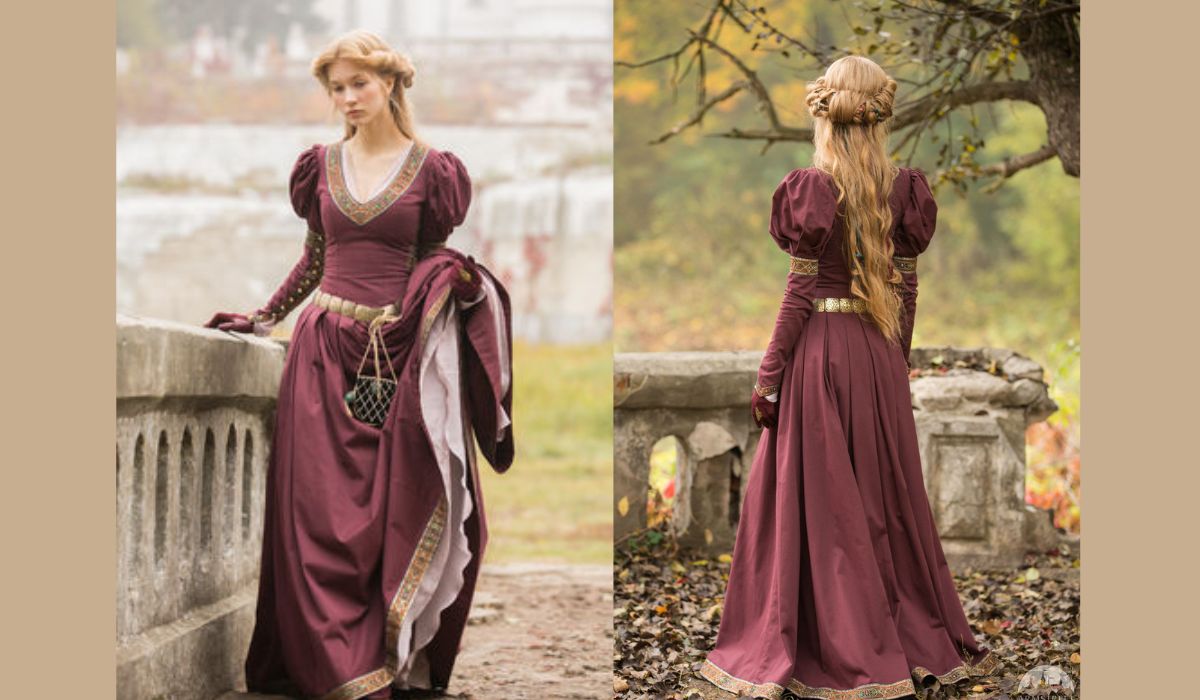The clothes of the Middle Ages are appealing because of their historical significance and classic beauty. Once a badge of prestige and history, these clothing have forever altered the course of style. In this essay, we will travel back in time to examine the interesting world of mediaeval clothing, namely, the garments worn during that era.
Introduction to Medieval Dresses
Dresses from the Middle Ages, commonly known as mediaeval apparel, include a vast variety of styles worn roughly between the 5th and 15th centuries. These garments served as more than just modesty coverings; they also communicated the wearer’s socioeconomic and cultural status.
The Evolution of Medieval Fashion
There were several shifts in mediaeval dress throughout the centuries. The progression of mediaeval fashion from the plain and practical clothes of the early Middle Ages to the ornate and complicated styles of the late Middle Ages reflects the shifting social mores and values of the era.
Types of Medieval Dresses
Peasant Attire
Commoners in the Middle Ages tended to dress simply and functionally. Wool and linen were used for making tunics, basic garments, and cloaks. The quality and ease of wearing these clothing was a primary design goal.
Noble Gowns
Royalty and the nobility wore the finest garments. Their signature fashion statement was ostentatious gowns adorned with expensive jewels and elaborate needlework. Silk, satin, and velvet were popular because they were seen as symbols of wealth and social prestige.
Knight’s Armor
The mediaeval ideal of chivalry, the knight, wore bulky suits of armour. Although not gowns in the modern sense, suits like this were an essential part of the mediaeval wardrobe.
Fabrics and Materials
Different textiles were employed by mediaeval dressmakers for different social classes. The lower classes typically dressed in linen, wool, and hemp, while the aristocratic classes favoured silk, velvet, and brocade.
Clothing Accessories in Medieval Times
Headwear
Accessorising with a suitable head covering was an important part of mediaeval attire. Commoners typically sported plain hoods or coifs, whereas nobility donned elaborate crowns and tiaras.
Footwear
Shoes Shoes were made to be worn on the feet. Those of aristocratic birth wore more ornately designed footwear, sometimes with pointed toes, whereas commoners stuck to simple leather shoes.
Medieval Dressing Etiquette
Dress regulations were rigidly enforced in Mediaeval society, which was otherwise highly organised. The clothes you wore were a reflection of your status in society, and wearing something out of place may get you in trouble.
Medieval Dresses in Modern Fashion
Dresses from the Middle Ages continue to influence today’s fashion industry. Corsets, bell sleeves, and elaborate embroidery are just a few examples of the vintage details that have found their way into today’s fashion.
The Symbolism of Medieval Attire
The Symbolism of Mediaeval Clothes Mediaeval clothes were full of meaning. There was significant meaning attached to one’s choice of clothing, from the colours and textiles to the accessories.
Influences on Contemporary Fashion
There is no denying the profound influence that mediaeval garments have had on modern attire. There are many examples of mediaeval influences in today’s fashion, from the red carpet to everyday attire.
Preservation of Medieval Garments
Due to their age and frail nature, mediaeval garments can be difficult to preserve. Museums and private collectors play an essential role in protecting great works of art for future generations.
Famous Medieval Dress Moments
Famous people and moments in history will always be linked to particular mediaeval garments. Consider the armour worn by Joan of Arc or the lavish clothing worn by Queen Isabella of Castile.
The Iconic Corset
Our fascination with mediaeval and Renaissance clothing, especially the corset, shows no signs of waning. It has had an indisputable impact on the way women’s bodies are shaped.
The Influence of Royalty
Kings and queens of the Middle Ages set fashion trends with the clothes they wore. Royal attire continues to pique the interest of fashion designers today.
Conclusion
Dresses from the Middle Ages continue to pique people’s interest since they are both beautiful and historically informative. Their universal appeal has stood the test of time and serves as a reminder that fashion is a universal language.
Also Read: The Ultimate Guide to SHEIN Wedding Dresses: Affordable Elegance for Your Special Day
Frequently Asked Questions (FAQs)
Were medieval dresses uncomfortable to wear?
Different fabrics and cuts made mediaeval garments more or less practical for daily wear. Some were cumbersome and limiting, while others were light and flexible.
How were medieval dresses cleaned and maintained?
Due to its fragility, mediaeval clothing was difficult to clean. Washing hands softly and letting them dry naturally were commonplace.
Did medieval men wear dresses?
Some mediaeval males, particularly in certain societies, wore long tunics and robes that are very similar to current garments.
Were all medieval dresses highly embellished?
Certainly, not every mediaeval gown had elaborate trimmings. The elite embraced extravagance in their fashions, whereas commoners favoured simplicity and functionality.
What is the most famous medieval dress in history?
Queen Isabella of Castile’s wedding dress is typically cited as an example of a particularly lavish and symbolic mediaeval garment.











